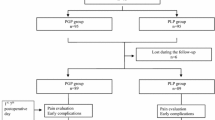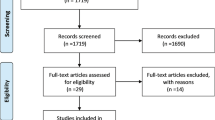Abstract
Purpose
The aim of the present randomised study was to find out whether usage of lightweight mesh in inguinal hernia repair, compared with heavyweight mesh, results in decreased incidence of chronic groin pain and foreign body feeling, as well as to evaluate the risk factors for chronic pain development and hernia recurrences.
Methods
The patients were randomised into the heavyweight mesh (HW) group and lightweight mesh (LW) group. A tension-free mesh repair using the Lichtenstein technique was performed on all patients. Pain scores during different activities were measured on visual analogue scale. All patients underwent a clinical examination for any evidence of hernia recurrence.
Results
Of the patients, 17.2 % in the HW group and 29.3 % in the LW group reported that they experienced pain at 3-year follow-up (P = 0.1323). Pain was most often reported during physical activity. The median VAS score of all studied activities was 30.5 in the HW group and 30.0 in the LW group. There were more patients in the HW group than in the LW group who stated that they could feel the mesh in the groin (27.6 vs. 20.7 %, P = 0.3967). Among all patients, 42.9 % who had severe pain preoperatively also reported pain during different activities and 19.6 % of the patients who did not have severe pain preoperatively reported pain during different activities (P = 0.0481). At 3-year follow-up, there was 1 hernia recurrence in the HW group and 1 hernia recurrence in the LW group.
Conclusions
Our study shows that compared with HW mesh, LW mesh has no advantage in reducing chronic groin pain and foreign body feeling at the operation site after inguinal hernioplasty at 3-year follow-up. Severe preoperative pain was correlated with the development of chronic pain. There was no difference between the two study groups in the recurrence rates.

Similar content being viewed by others
References
Simsons MP, Aufenacker T, Bay-Nielsen M, Bouillot JL, Campanelli G, Conze J, de Lange D, Fortelny R, Heikkinen T, Kingsnorth A, Kukleta J, Morales-Conde S, Nordin P, Schumpelick V, Smedberg S, Smietanski M, Weber G, Miserez M (2009) European hernia society guidelines on the treatment of inguinal hernia in adult patients. Hernia 13:343–403
EU Hernia Trialists Collaboration (2000) Mesh compared with non-mesh methods of open groin hernia repair: systematic review of randomized controlled trials. Br J Surg 87:854–859
Klinge U, Klosterhalfen B, Müller M, Schumpelick V (1999) Foreign body reaction to meshes used for repair of abdominal wall hernias. Eur J Surg 165:665–673
O’Dwyer PJ, Kingsnorth AN, Molloy RG, Small PK, Lammers B, Horeyseck G (2005) Randomized clinical trial assessing impact of a lightweight mesh or heavyweight mesh on chronic pain after inguinal hernia repair. Br J Surg 92:166–170
Post S, Weiss B, Willer M, Neufang T, Lorenz D (2004) Randomized clinical trial of lightweight composite mesh for Lichtenstein inguinal hernia repair. Br J Surg 91:44–48
Smietanski M (2008) Randomized clinical trial comparing a polypropylene with a poliglecaprone and polypropylene composite mesh for inguinal hernioplasty. Br J Surg 95:1462–1468
Bringman S, Wollert S, Österberg J, Smedberg S, Granlund H, Felländer G, Heikkinen T (2005) One year results of a randomised controlled multi-centre study comparing Prolene and Vypro II-mesh in Lichtenstein hernioplasty. Hernia 9:223–227
Koch A, Bringman S, Myrelid P, Smeds S, Kald A (2008) Randomized clinical trial of groin hernia repair with titanium-coated lightweight mesh compared with standard polypropylene mesh. Br J Surg 95:1226–1231
Nikkolo C, Lepner U, Murruste M, Vaasna T, Seepter H, Tikk T (2010) Randomised clinical trial comparing lightweight mesh with heavyweight mesh for inguinal hernioplasty. Hernia 14:253–258
Alfieri S, Amid PK, Campanelli G, Izard G, Kehlet H, Wijsmuller AR, Di Miceli D, Doglietto GB (2011) International guidelines for prevention and management of post-operative chronic pain following inguinal hernia surgery. Hernia 15:239–249
Bringman S, Wollert S, Österberg J, Smedberg S, Granlund H, Heikkinen TJ (2006) Three-year results of a randomized clinical trial of lightweight or standard polypropylene mesh in Lichtenstein repair of primary inguinal hernia. Br J Surg 93:1056–1059
Author information
Authors and Affiliations
Corresponding author
Rights and permissions
About this article
Cite this article
Nikkolo, C., Murruste, M., Vaasna, T. et al. Three-year results of randomised clinical trial comparing lightweight mesh with heavyweight mesh for inguinal hernioplasty. Hernia 16, 555–559 (2012). https://doi.org/10.1007/s10029-012-0951-0
Received:
Accepted:
Published:
Issue Date:
DOI: https://doi.org/10.1007/s10029-012-0951-0




